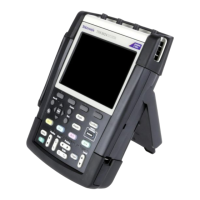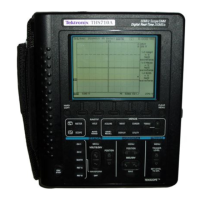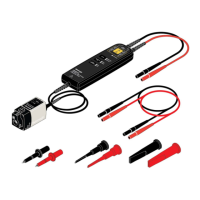
Do you have a question about the Tektronix THS3024 and is the answer not in the manual?
| Bandwidth | 200 MHz |
|---|---|
| Channels | 4 |
| Sample Rate | 2.5 GS/s |
| Input Coupling | AC, DC, GND |
| Time Base Range | 5 ns/div to 50 s/div |
| Battery Life | 4 hours |
| Operating Temperature | 0 °C to 50 °C |
| Vertical Resolution | 8 bits |
| Multimeter | No |
| Input Impedance | 1 MΩ |
| Maximum Input Voltage | 300 V (DC + peak AC) |
| Trigger Modes | Edge, Pulse, Video |
| Memory Depth | 10, 000 points (all channels) |
| Record Length | 10, 000 points |
| Display | 7 inch color TFT LCD |
Precautions to avoid injury and damage to the product and connected equipment.
Definitions of terms used in the manual and symbols found on the product.
Details the manual's chapters and where to find additional information.
Introduces the oscilloscope, its features, and initial configuration steps.
Guides on connecting BNC inputs, floating measurements, and probes.
Setting probe type, attenuation, sensitivity, and input options.
Using Autoset, AutoRange, measurements, and stopping the display.
Employing averaging, persistence, glitch capture, math, compare, and pass-fail testing.
Introduces recorder functions like TrendPlot and Scope Roll Mode.
Plots measurement values as a function of time.
Captures waveforms in deep memory for extended periods.
Reviews and navigates through captured waveform screens.
Detailed waveform viewing and precise measurements using cursors.
Explains trigger event, modes, and basic setup principles.
Details edge, auto, single shot, N-event, video, and pulse width triggers.
Saving, renaming, copying, and deleting files.
Accessing saved waveform data and configurations for analysis.
Solutions for shutdown, black screen, and power-off issues.
Addresses problems with OpenChoice™ Desktop recognition.
Covers performance, environmental, safety, and input characteristics.
Details automatic measurements, recorder, zoom, data log, and cursor specs.
Covers power, ports, mechanical, environmental, and safety specs.
Connects instrument via USB and installs necessary drivers.
Confirms connection and installs OpenChoice™ Desktop software.
Adjusts probes for optimal response to input channels.
Lists maximum voltage limits for various probes.
Manages instrument power conservation settings.
Instructions for charging the Li-ion battery pack.
Guidelines for cleaning, maintenance, and long-term storage.











